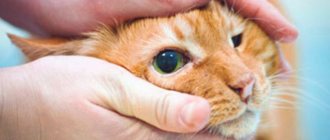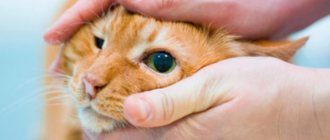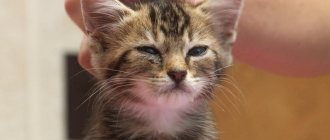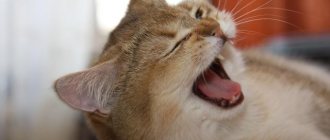10199Administration
All cats sneeze from time to time and, I must admit, it looks pretty funny. However, if a kitten is sneezing and its eyes are watery, this combination of symptoms should cause concern rather than a smile in its owner.
The causes of sneezing in a kitten can be different. The most common are:
- Various infectious diseases;
- Allergic reaction to any irritant;
- Injury or foreign bodies in the nose
It can be extremely difficult to independently determine the exact causes of a pet’s illness and can only be done by a specialist.
© shutterstock
Therefore, if your kitten begins to sneeze very often and his eyes are very watery, it is better to immediately contact a veterinarian.
There are situations in which it is impossible to get immediate qualified help. In this case, you can try to alleviate your pet’s condition by using our advice.
Why does a cat sneeze and her eyes water?
In fact, there can be many reasons for this condition of a pet: from the simplest to quite serious. Below we will look at some of the most common ones:
- Common mucosal irritation. It can be caused by dust or tobacco smoke, for example. In this case, there is no need to worry - you need to get rid of the possible irritant.
- Allergy. Cats, like humans, can have allergies to pollen, perfumes and plants. It may be accompanied not only by sneezing and watery eyes, but also by vomiting, shortness of breath and a rash.
- Cold. In this case, your pet will have a fever, lethargy and cough. A veterinarian's consultation is necessary for an accurate diagnosis.
- Injury. If something gets into your nose or eye, you may experience watery eyes and sneezing. The solution is to remove the possible irritant and treat the eye and nose with saline solution or plain water.
- Asthma will be accompanied by wheezing and increased coughing. And sneezing and tears will be a consequence of this condition.
- Parasites can also cause tears and sneezing. And if you haven’t treated your cat and she has, among other things, vomiting and diarrhea, you need to get tested for helminths.
- Conjunctivitis. In this condition, the cat's eyes suffer more - pus and redness appear. A veterinarian can prescribe the correct treatment.
Diagnostic methods
At home, it is difficult to determine the exact cause of the cat’s deterioration. You need to seek help from a veterinarian . During the diagnosis, the animal is examined, body temperature is measured, and an anamnesis is collected by interviewing the cat's owner.
The following studies are prescribed:
- general and biochemical blood test;
- Analysis of urine;
- taking swabs from the nasal cavity and throat;
- nasal endoscopy;
- X-ray of the head.
Could these be symptoms of dangerous diseases?
If a kitten or adult cat's eyes are watery and he/she is sneezing, a serious medical condition may be present. Only a veterinarian can diagnose it, so if you notice additional symptoms, you should immediately consult a doctor.
Dangerous accompanying symptoms:
- The cat vomits frequently and has diarrhea.
- The color of the eyes changed and became darker.
- Sudden weight gain or loss.
- Fever and high temperature.
- Lethargy, apathy.
- Blood in the discharge from the nose or eyes.
- Severe swelling of the mucous membranes.
- Cough and difficulty breathing.
- Skin rashes and ulcers.
The presence of these symptoms may be a sign of feline immunodeficiency virus, rhinotracheitis, calicivirus, infectious diseases and other diseases dangerous to pets.
Important: if you pick up a pet and it exhibits similar symptoms, do not rush to take it home to other animals, they may become infected with one of the infectious diseases.
Features of symptoms
Sneezing is not the only symptom indicating that your pet is unwell. Depending on the cause and degree of neglect of the disease, the following clinical manifestations develop:
- eyes are swollen, lacrimation is small, moderate;
- the hair around the eyes falls out, eczema and dermatitis develop;
- the consistency of the discharge changes;
- the animal rubs its head on various objects due to itching;
- dry discharge in the corners of the eyes;
- redness, swelling of the conjunctiva;
- fear of light.
If your pet is constantly sneezing and the tearing does not go away, you need the help of a veterinarian. The doctor will tell you what to do to eliminate the symptoms after an accurate diagnosis is made.
How to put drops in a cat's eyes and nose?
Cats are wayward animals and may simply refuse to carry out any procedures, and during illness it may be more difficult for them to bear such stress.
Below are a few steps to complete the procedures without much hassle.
Drops in the eyes
- It is better to perform the procedure together, so that one drips and the other holds.
- Secure your pet's head with a towel.
- Clean any discharge from your eyes using a damp cotton pad.
- Pull back your eyelid and apply.
- Do not let go of your pet for several minutes so that the drug is absorbed.
Nasal drops
- Fix the muzzle vertically. Your left thumb should rest on the chin, and your index finger should rest on your pet's forehead.
- With your right hand, take the medicine and inject or drop it.
Carry out the manipulations calmly, your behavior will affect the pet. Afterwards, be sure to praise your pet and give him a treat.
With the help of drugs
When an animal sneezes and its pupils are watery, the doctor suggests treatment with the following means:
- Anandin. This medicine helps in rapid healing of wounds and has antimicrobial effects;
- Maxidin. Has good immunostimulating properties. May help with inflammation of the eyes and rhinitis;
- Thymogen. This is a drug that regulates the immune system.
If no positive trends are observed, then, on the recommendation of a doctor and under his supervision, the following pills should be taken:
- Naphthyzin. It comes in the form of nasal or eye drops. Has the property of constricting blood vessels and has an antiphlogistic effect;
- Dioxidine. It is used for purulent rhinitis and has disinfectant properties;
- Derinat. Helps strengthen the immune system, used mainly for rhinitis and conjunctivitis;
- Nazivin. It comes in the form of drops: both for the nose and for the eyes. Used to reduce inflammation in these areas.
© shutterstock
If the cat has a serious illness, then the following medications are prescribed:
- Drops "Diamond eyes". They have an antimicrobial and regenerating effect thanks to components such as chlorhexidine, sodium succinate and taurine;
- Furacilin. It is contained in the drug "Bars", which fights microbes well. Novocaine, which is part of it, anesthetizes. Prescribed for severe keratitis;
- “Iris” is the name given to the drops that are used to treat a corneal ulcer. The composition contains the antibiotic gentamicin and many healing elements;
- To treat inflammation of the conjunctiva, Ciprovet is used, which contains the antibiotic ciprofloxacin.
How to alleviate the course of the disease?
- Make sure that the cat feels safe: there should be no loud noises, drafts, excessive heat and low or high humidity. The cat should be able to go to a secluded place.
- The cat must drink. If this does not happen, the owner must feed the pet with a syringe or pipette.
- The cat must eat.
- Do not deviate from the chosen course of treatment and be sure to complete it.
- Be patient, calm and give your cat more attention and affection.
When is help needed?
If your animal has the following symptoms, then a trip to the veterinarian is required:
- the cat is constantly sneezing;
- his eyes are watering;
- no appetite;
- irritation and itching in the area of the visual organ;
- purulent discharge;
- the eyes became a different color and became cloudy;
- the animal is very lethargic or, on the contrary, overexcited;
- There are deep wounds and cuts.
The doctor will conduct an examination and prescribe the right treatment, thanks to which you will not hear or see your baby sneezing or his eyeballs watering.
How to prevent such a situation?
Treating is always more difficult than preventing a disease. Because in reality, not much is required from the owner:
- treat your pet carefully and monitor for possible changes in behavior and appearance;
- carry out regular vaccinations;
- keep your cat's toys and litter box clean;
- rinse eyes and clean if lumps form;
- carry out deworming once every three months;
- feed correctly and prevent “table food”;
- provide access to clean and fresh water;
- Visit the veterinarian at least once a year and promptly contact the veterinarian for any changes.
Causes and types of food poisoning
In general, there are 2 main causes of food poisoning:
- The body's reaction to foods that differ from the daily diet2.
- pathogenic flora (bacteria, fungi), viruses and toxins that enter the body mainly with contaminated food.
Every corner of the world has its own infectious agents, and they are ready to instantly attack the human gastrointestinal tract, if you just gape.
During the hot season, the chance of getting poisoned increases many times over, because food is stored less and bacteria multiply much faster. Food poisoning is especially common when traveling, so there is a separate concept - “traveler's diarrhea.” Going south, to Asia, the Middle East, Africa, South America or hot islands, we endure a sharp change in climate zone, try unusual national cuisine and drink local water. All this, combined with bacteria and viruses new to our body, can cause food poisoning.
In the US, it has been estimated that out of 1,000 people who become ill after traveling, 1/3 always suffer from diarrhea and food poisoning. E. coli is becoming the most common cause of severe diarrhea abroad1.
A child's body is even more vulnerable. For a fragile body, the cause of poisoning can be anything, especially when traveling: unwashed hands, playing in the sand, unusual sweets or fruits. An accidental sip of water from a pool or sea can also affect a child's intestinal health.
Treatment of food poisoning
First of all, to restore the body, you need dietary nutrition, which will help restore normal functioning of the gastrointestinal tract (GIT).
When resuming nutrition after poisoning, general recommendations must be followed3:
- You need to eat often and in small portions.
- Fried, stewed, spicy, salty and fatty foods are strictly prohibited.
- Alcohol and carbonated sweet drinks should be forgotten during treatment and further recovery.
- It is important to maintain the serving temperature of the food - it should remain neutral - neither cold nor hot.
- The predominant cooking method is boiling and steaming.
- Dishes should be light, mostly lean and familiar to the body.
A home or traveler's first aid kit should always include anti-poisoning medications.
The most popular products3,4:
- Adsorbent preparations or sorbents. No first aid kit should be without such a product. The task of the sorbent is to absorb the toxin and its further removal from the body.
- Drugs to improve digestion. They help the body fully absorb food and will be especially relevant after defeating poisoning.
- Antispasmodics or painkillers. Spasms and pain in the stomach or intestines can also be the body’s reaction to an external “attack”. The task of such medications is to relax the internal muscles and relieve spasms, as a result of which the pain goes away.
When faced with food poisoning, it is first of all important to cope with the acute period of the problem, but it is equally important to think about the period of rehabilitation of the digestive system, because the inflammatory process disrupts its normal functioning. One of the consequences of such a disorder may be a lack of digestive enzymes, which are responsible for the breakdown and absorption of food in the body. As a result, the body experiences a deficiency of nutrients, and a person, even after recovery, may still experience unpleasant symptoms for some time - discomfort in the abdomen, heaviness after eating, periodic bowel movements, etc.
Pancreatin enzyme preparations may be useful to maintain digestion after poisoning5. They are called enzymatic because they contain digestive enzymes identical to those produced by the body and are included in the standard treatment of foodborne infections6.
Digestive enzymes are a special type of compound designed to break down carbohydrates, proteins and fats for subsequent absorption in the body.
Prevention
A cold is not dangerous for an animal with normal immunity, but the disease causes discomfort to the cat and is quite difficult to treat. It is much easier to prevent infection. The following measures help with this:
- Proper care of animals. For the first few weeks of life, kittens should be kept in a warm, draft-free room. Trays and sleeping places for adult animals should also not be in rooms with cold air.
- Gradual adaptation to the street. You need to start this procedure in the warm season. The cat is allowed outside for several hours. In this case, you need to ensure that the animal does not become hypothermic. In rainy and windy weather, walks are avoided.
- Proper bathing. The cat needs to be bathed with warm water. After the procedure, the fur is thoroughly dried with a towel, while the pet should be in a warm room.
- Proper nutrition. The diet should include balanced food and sufficient fluids. Do not give your cat cold food or water.
Possible consequences of a cold
It can be difficult for cat owners to understand that the disease is not typical for a small predator, and the complications, if left untreated, are extremely dangerous. A cat's illness rarely poses a danger to the human body, but can be transmitted to other four-legged and feathered inhabitants of the apartment.
If you ignore the primary symptoms and do not start treatment in time, the disease progresses to a serious stage.
Typical complications:
- bronchitis,
- pneumonia,
- joint damage,
- genitourinary infections.
Also, the immune system weakened by the disease is a poor “protector” for the animal. Viruses brought by the owner on street clothes and shoes can easily infect a sick body.











